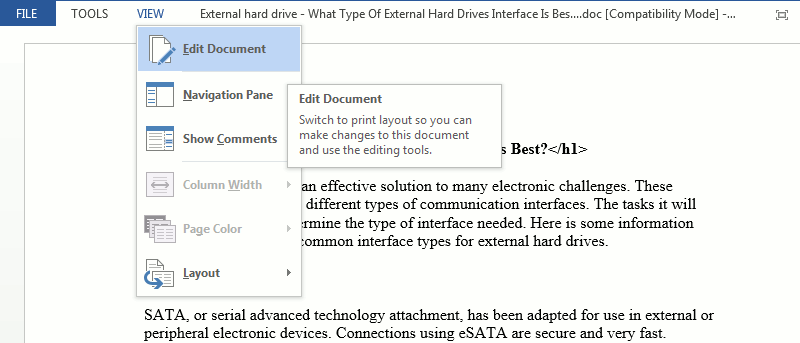Navigating the Realm of Serenity: A Comprehensive Exploration of Comfortable Reading in Read Mode in Microsoft Word 2013

Introduction:
In the digital age, where information is abundantly disseminated through various mediums, the importance of creating a comfortable and immersive reading experience cannot be overstated. Microsoft Word 2013 introduces a transformative feature designed to elevate the act of reading within its interface – Read Mode. This article embarks on a thorough exploration of Read Mode, unraveling its nuances and shedding light on how this feature redefines the reading experience for users within the Microsoft Word 2013 environment.
Read Mode Unveiled:
Read Mode in Microsoft Word 2013 is a feature specifically engineered to optimize the reading experience by stripping away distractions and enhancing readability. Activating Read Mode transforms the traditional document view into a clean and streamlined layout, creating an environment conducive to focused and comfortable reading. This mode caters to a diverse audience, from students and professionals to avid readers and researchers, offering a serene space to absorb information without unnecessary visual clutter.
Layout and Typography Optimization:
At the heart of Read Mode lies a meticulous focus on layout and typography. Microsoft Word 2013’s Read Mode employs responsive design principles, ensuring optimal readability across various devices and screen sizes. The font size, spacing, and line length are carefully calibrated to reduce eye strain and facilitate a seamless reading experience. Users can customize these settings further, tailoring the reading environment to their personal preferences.
Column Width and Page Color:
Read Mode grants users the flexibility to adjust column width, a feature that proves invaluable in tailoring the reading experience to individual needs. Whether users prefer a traditional single-column layout or a more magazine-style approach with multiple columns, Microsoft Word 2013 caters to diverse reading preferences. Furthermore, the option to customize page color enhances user comfort, allowing for a personalized visual experience that caters to different lighting conditions and user preferences.
Immersive Multimedia Integration:
Beyond the traditional realms of text, Read Mode in Microsoft Word 2013 embraces multimedia integration to enrich the reading experience. Users can seamlessly embed images, videos, and other multimedia elements within the document, fostering a more immersive and engaging reading experience. This integration is particularly beneficial for educational materials, reports, and presentations, where a multimedia component can enhance comprehension and retention.
Navigation and Accessibility Features:
Read Mode prioritizes ease of navigation, ensuring that users can effortlessly traverse through lengthy documents. The intuitive navigation panel provides quick access to various sections of the document, allowing users to jump between pages, chapters, or sections seamlessly. Additionally, Read Mode enhances accessibility with features such as text-to-speech, making it an inclusive tool for users with diverse needs.
Annotation and Collaboration:
Recognizing the collaborative nature of document creation and review, Read Mode in Microsoft Word 2013 doesn’t compromise on functionality. Users can seamlessly switch between Read Mode and Edit Mode, allowing for real-time collaboration and annotation. This duality ensures that the comfort of reading doesn’t come at the expense of collaboration, making Microsoft Word 2013 a versatile platform for both individual and collaborative projects.
Customization and User Preferences:
One of the defining strengths of Read Mode lies in its commitment to user customization. Microsoft Word 2013 empowers users to tailor the reading experience to their liking, from adjusting font styles to choosing background colors. This flexibility accommodates various reading environments and user preferences, making Read Mode a versatile tool for a diverse user base.
Conclusion:
As the digital landscape continues to evolve, the importance of a comfortable and immersive reading experience cannot be overstated. Microsoft Word 2013’s Read Mode emerges as a beacon of innovation, redefining how users engage with written content. From layout and typography optimization to immersive multimedia integration, Read Mode strikes a delicate balance between simplicity and functionality. As users embrace the tranquility of Read Mode, Microsoft Word 2013 stands as a testament to the commitment to providing tools that transcend mere functionality, offering an enriching and enjoyable reading experience. In the ever-expanding universe of digital documentation, Read Mode is a testament to Microsoft’s dedication to creating tools that enhance, rather than merely facilitate, the user experience. Welcome to the future of comfortable reading, where Microsoft Word 2013’s Read Mode invites you to immerse yourself in the joy of reading without compromise.





